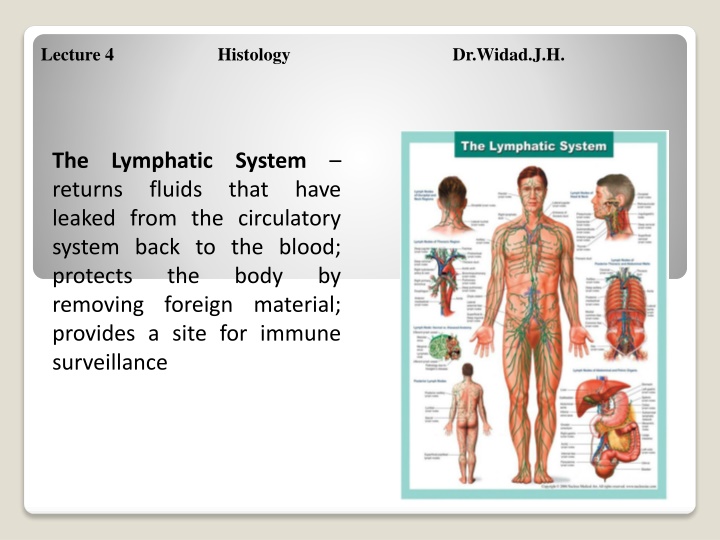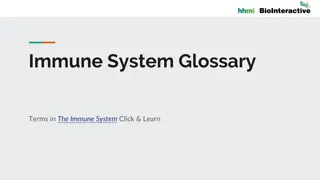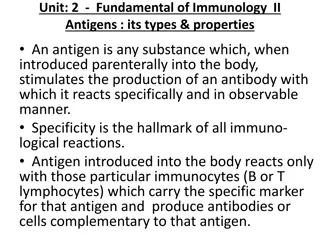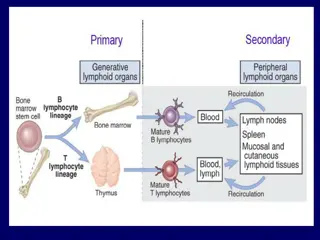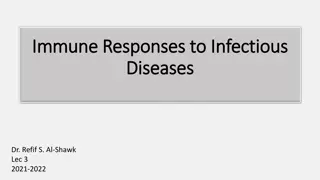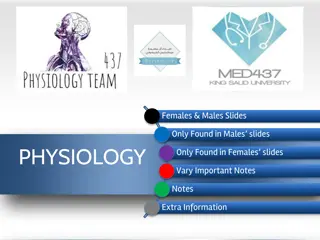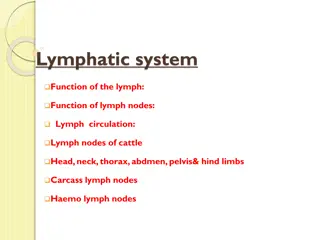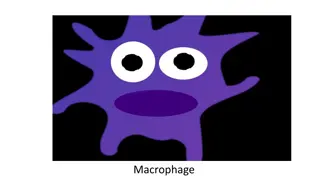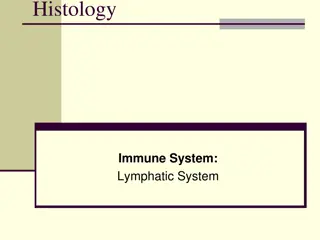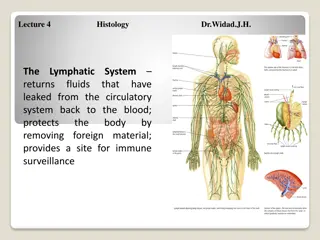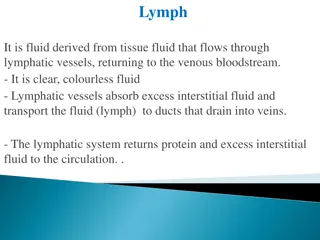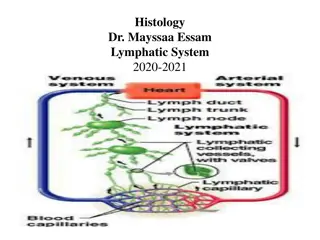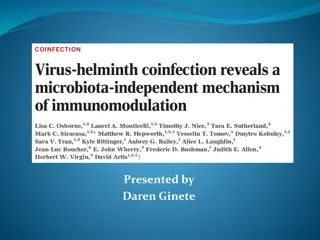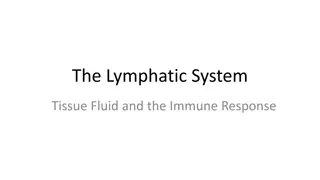Lymphatic System Function and Immune Response Overview
The lymphatic system plays a crucial role in maintaining fluid balance, immune surveillance, and protection against foreign invaders. It includes lymphoid cells such as T and B lymphocytes, macrophages, and dendritic cells, which work together to defend the body. The immune response involves T cells for cellular immunity and B cells for humoral immunity. Components of the lymphatic system, such as lymphatic vessels and capillaries, aid in returning fluids to the blood and absorbing fats. Understanding these mechanisms is essential for overall health and immunity.
Download Presentation

Please find below an Image/Link to download the presentation.
The content on the website is provided AS IS for your information and personal use only. It may not be sold, licensed, or shared on other websites without obtaining consent from the author.If you encounter any issues during the download, it is possible that the publisher has removed the file from their server.
You are allowed to download the files provided on this website for personal or commercial use, subject to the condition that they are used lawfully. All files are the property of their respective owners.
The content on the website is provided AS IS for your information and personal use only. It may not be sold, licensed, or shared on other websites without obtaining consent from the author.
E N D
Presentation Transcript
Lecture 4 Histology Dr.Widad.J.H. The Lymphatic System returns fluids that have leaked from the circulatory system back to the blood; protects the removing foreign material; provides a site for immune surveillance body by
The Immune Response T cells = cellular immunity; function to amplify the inflammatory response B cells = humoral immunity T Cells and Cell Mediated Immunity - targets virus or parasite infected cells, cancer cells, and cells of foreign grafts 3 main types of cells: 1. Cytotoxic T (TC) cells: carry out cell mediated immunity, physically attack foreign cells 2. Helper T (TH) cells: activate B and TC cells 3. Suppressor T (TS) cells: moderate the immune response by inhibiting TC and B cells
Lymphoid cells Lymphocytes Arise in the red bone marrow Protect the body against antigens Two types T lymphocytes (T cells) oMature in the thymus oDirectly attack and destroy foreign cells B lymphocytes (B cells) oMature in the bone marrow oProduce manufacture antibodies plasma cells that
Macrophages substances and activate the T cell response Dendritic cells initiate the immune response Reticular cells produce the reticular fibers that form the soft skeletal structure of lymphoid organs phagocytize foreign
Components of the Lymphatic System Lymphatic vessels return to the blood any fluids that have escaped from the circulation Distribution of lymphatic vessels Lymphatic vessels travel alongside blood vessels Lymphatic vessels are absent from bones, teeth, bone marrow, and the central nervous system Lymphatic capillaries microscopic blind-ended tubes that are interwoven between the tissue cells and the blood capillaries Lacteals specialized lymphatic capillaries of the intestinal mucosa Fatty lymph (chyme) containing fats and fat-soluble substances is absorbed in the lacteals
Lymph transport The lymphatic circulation is a low-pressure system The lymphatic system lacks a pumping organ; must utilize the valves, respiratory pumps and muscular pumps to promote lymph flow toward the heart The movement of surrounding tissues is also important in propelling lymph through the lymphatics The lymphatic capillaries converge into larger vessels Lymph flows from the lymphatic capillaries to lymphatic collecting vessels to lymphatic trunks to the right lymphatic duct/thoracic duct
The right lymphatic duct drains lymph from the right upper arm and the right side of the head and thorax The thoracic duct receives lymph from the rest of the body
Lymphoid cells and tissues Cells Lymphocytes Arise in the red bone marrow Protect the body against antigens Two types T lymphocytes (T cells) oMature in the thymus oDirectly attack and destroy foreign cells B lymphocytes (B cells) oMature in the bone marrow oProduce plasma cells that manufacture antibodies
Macrophages phagocytize foreign substances and activate the T cell response Dendritic cells initiate the immune response Reticular cells produce the reticular fibers that form the soft skeletal structure of lymphoid organs
Lymph nodes Only the lymph nodes filter lymph Cluster along the lymphatic vessels of the body Lymph is filtered through the lymph nodes before it is returned to the bloodstream Lymph nodes are embedded in connective tissue Large clusters of lymph nodes appear near the body surface in the inguinal, axillary, and cervical regions. Functions of lymph nodes Filters lymph Assist in activating the immune system
Anatomy of a lymph node Most are kidney-shaped Surrounded by a fibrous capsule Strands of connective tissue (trabeculae) divide the node into compartments Two histologically distinct regions Cortex oContains densely packed follicles with many germinal centers oDeeper portion of the cortex primarily houses T cells Medulla oContain both types of lymphocytes
Circulation in the lymph nodes Afferent lymphatic vessels lymph enters here Once inside the nodes, the lymph moves through a series of sinuses and then exits at the hilus Efferent lymphatic vessels lymph exits here
Spleen The largest lymphoid organ Site of lymphocyte proliferation and immune surveillance and response Functions of the spleen Cleanses the blood by removing old RBCs and platelets, as well as debris from the blood. Stores the breakdown products of RBCs Site of erythrocyte production in the fetus
Anatomy of the spleen Surrounded by a fibrous capsule Contains both T cells, B cells, RBCs and macrophages Divided histologically into two regions Red pulp rich in lymphocytes and reticular fibers oRBC disposal and recycling White pulp rich in macrophages and reticular fibers oImmune functions
Thymus the site of T cell maturation Most active in younger children; atrophies with age Does not contain reticular fiber Lack B cells, therefore no germinal cells enters are present in the thymus
Tonsils the simplest lymphoid organs; named according to their location Palatine tonsils Lingual tonsils Pharyngeal tonsil Tubal tonsils
Aggregates of lymphoid follicles Location of these follicles make them ideal because they are able to: Destroy bacteria and prevent pathogens from slipping through the intestinal wall Generate many memory lymphocytes for long- term immunity Examples Peyer s patches found in the distal portion of the small intestine Appendix an off-shoot of the cecum (the first part of the large intestine)
